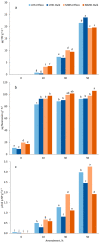Can Lunar and Martian Soils Support Food Plant Production? Effects of Horse/Swine Monogastric Manure Fertilisation on Regolith Simulants Enzymatic Activity, Nutrient Bioavailability, and Lettuce Growth
- PMID: 36501382
- PMCID: PMC9740528
- DOI: 10.3390/plants11233345
Can Lunar and Martian Soils Support Food Plant Production? Effects of Horse/Swine Monogastric Manure Fertilisation on Regolith Simulants Enzymatic Activity, Nutrient Bioavailability, and Lettuce Growth
Abstract
To make feasible the crewed missions to the Moon or Mars, space research is focusing on the development of bioregenerative life support systems (BLSS) designed to produce food crops based on in situ resource utilisation (ISRU), allowing to reduce terrestrial input and to recycle organic wastes. In this regard, a major question concerns the suitability of native regoliths for plant growth and how their agronomic performance is affected by additions of organic matter from crew waste. We tested plant growth substrates consisting of MMS-1 (Mars) or LHS-1 (Lunar) simulants mixed with a commercial horse/swine monogastric manure (i.e., an analogue of crew excreta and crop residues) at varying rates (100:0, 90:10, 70:30, 50:50, w/w). Specifically, we measured: (i) lettuce (Lactuca sativa L. cultivar 'Grand Rapids') growth (at 30 days in open gas exchange climate chamber with no fertilisation), plant physiology, and nutrient uptake; as well as (ii) microbial biomass C and N, enzymatic activity, and nutrient bioavailability in the simulant/manure mixtures after plant growth. We discussed mechanisms of different plant yield, architecture, and physiology as a function of chemical, physico-hydraulic, and biological properties of different substrates. A better agronomic performance, in terms of plant growth and optically measured chlorophyll content, nutrient availability, and enzymatic activity, was provided by substrates containing MMS-1, in comparison to LHS-1-based ones, despite a lower volume of readily available water (likely due to the high-frequency low-volume irrigation strategy applied in our experiment and foreseen in space settings). Other physical and chemical properties, along with a different bioavailability of essential nutrients for plants and rhizosphere biota, alkalinity, and release of promptly bioavailable Na from substrates, were identified as the factors leading to the better ranking of MMS-1 in plant above and below-ground mass and physiology. Pure Mars (MMS-1) and Lunar (LHS-1) simulants were able to sustain plant growth even in absence of fertilisation, but the amendment with the monogastric manure significantly improved above- and below-ground plant biomass; moreover, the maximum lettuce leaf production, across combinations of simulants and amendment rates, was obtained in treatments resulting in a finer root system. Increasing rates of monogastric manure stimulated the growth of microbial biomass and enzymatic activities, such as dehydrogenase and alkaline phosphomonoesterase, which, in turn, fostered nutrient bioavailability. Consequently, nutrient uptake and translocation into lettuce leaves were enhanced with manure supply, with positive outcomes in the nutritional value of edible biomass for space crews. The best crop growth response was achieved with the 70:30 simulant/manure mixture due to good availability of nutrients and water compared to low amendment rates, and better-saturated hydraulic conductivity compared to high organic matter application. A 70:30 simulant/manure mixture is also a more sustainable option than a 50:50 mixture for a BLSS developed on ISRU strategy. Matching crop growth performance and (bio)chemical, mineralogical, and physico-hydraulic characteristics of possible plant growth media for space farming allows a better understanding of the processes and dynamics occurring in the experimental substrate/plant system, potentially suitable for an extra-terrestrial BLSS.
Keywords: Mars and Lunar simulants; bioregenerative life support systems; extra-terrestrial food production; organic amendment; space farming; sustainable use of resources.
Conflict of interest statement
The authors declare that they have no known competing financial interest or personal relationships that could have appeared to influence the work reported in this paper.
Figures



References
-
- Fackrell L.E. Plant growth experiments using martian simulants: Potential and limitations of agriculture on Mars; Proceedings of the Geology Conference Paper; 2021. [(accessed on 25 October 2022)]. p. Abtract 1634. Available online: https://ui.adsabs.harvard.edu/abs/2021LPI....52.1684F/abstract.
-
- Gilrain M.R., Hogan J.A., Cowan R.M., Finstein M.S., Logendra L.S. Preliminary Study of Greenhouse Grown Swiss Chard in Mixtures of Compost and Mars Regolith Simulant; Proceedings of the SAE Technical Paper; 1999. [(accessed on 25 October 2022)]. p. No. 1999-01-2021. Available online: https://www.sae.org/publications/technical-papers/content/1999-01-2021/
-
- Mortley D.G., Aglan H.A., Bonsi C.K., Hill W.A. Growth of Sweetpotato in Lunar and Mars Simulants; Proceedings of the SAE Technical Paper; 2000. [(accessed on 25 October 2022)]. p. No. 2000-01-2289. Available online: https://www.sae.org/publications/technical-papers/content/2000-01-2289/
-
- Caporale A.G., Vingiani S., Palladino M., El-Nakhel C., Duri L.G., Pannico A., Rouphael Y., De Pascale S., Adamo P. Geo-mineralogical characterisation of Mars simulant MMS-1 and appraisal of substrate physico-chemical properties and crop performance obtained with variable green compost amendment rates. Sci. Total Environ. 2020;720:137543. doi: 10.1016/j.scitotenv.2020.137543. - DOI - PubMed
LinkOut - more resources
Full Text Sources
Miscellaneous

